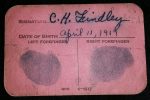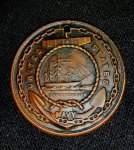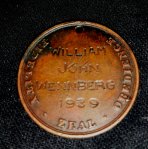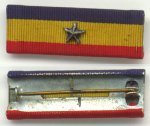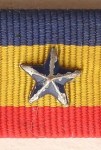Category Archives: Ribbons
Patrolling For USS Vincennes Veterans: A Subtle Naval Aviator Find
In reviewing the archive of previous articles on this site, it is becoming apparent to me that a few trends have truly taken shape with both the subject matter and the items that I have been pursuing for my collection. Specializing or focusing one’s collection helps provide direction, structure and boundaries for pursuits that will empower collectors to have discipline when “cool” pieces or “good deals” surface but are outside of the lines. As has been previously recommended, focusing prevents collectors from being overwhelmed and crowded-in with too many items. Perhaps readers can already determine the direction of this article without reading further and maybe those who choose to continue from this point will be rewarded with a compelling story or information about a piece.

When I received this message from colleague, my heart leaped and I hurried to check out the listing.
I make no secrets about the sort of pieces that I pursue with my collecting interests and I am reminded constantly by friends, family and colleagues that I have been effective in communicating my activities. When I received a private message from a collector colleague regarding an auction listing that detailed a uniform item from a naval aviator who had served aboard the heavy cruiser, USS Vincennes (CA-44) before World War II, I was compelled to check into the auction. When I attempted to access the link to the auction listing that accompanied the message, the listing had closed, though without a bid being submitted.

Commander John Ramee’s jacket label from the Naval Uniform Shop of Brooklyn, NY, Note the remarks (blue gaberdine, ribbons and aviator wings) mentioned at the bottom.
The item shown in the listing was a naval officer’s service dress blue uniform jacket. The sleeve cuffs were each adorned with three, same-sized gold bullion stripes, indicating that the original owner held the rank of a line officer commander. On the left breast of the jacket is a custom-made ribbon bar that told of the officer’s service which included duty before, during and after World War II (through the Korean War). Inside the right side of the jacket, the Naval Uniform Shop – Brooklyn label with the name, “J. Ramee” along with the date that it was either ordered or made (November 8, 1955). The tailor’s information specifying the customer’s request is imprinted on the label (in addition to the commander’s name and possibly his service number): blue gaberdine material and including customized aviator’s wings and ribbons – both secured in place. All of the information on the label matched the construction of the jacket with one significant exception, the lack of aviator’s wings.

Note the ghosting of the (now removed) bullion naval aviators wings above Commander Ramee’s custom ribbon rack (see below for ribbon details).
A close inspection of the photos within the listing reveals the ghost-imprint of the former placement of bullion wings which where, quite obviously removed by a militaria collector in search of a quick profit. While the uniform jacket has some monetary value to militaria collectors, those who specialize in the adornments (collar devices, warfare devices such as wings, combat badges, etc., medals and ribbons and sleeve insignia) seldom desire a full uniform (or the commitment to preservation and storage such pieces require) for their collection. This “Ramee” jacket was quite obviously chopped for its most valuable element.
What drew my attention to the uniform jacket was the same aspect that led my collector colleague to reach out to me regarding the listing. A cursory search for information regarding Commander J. Ramee produced fantastic results. Besides Ramee being a very unique name (the only one listed in the Naval Officers Registers during the period of time in which this man served was John Ramee), it was one of his earliest assignments that stood out to me – he served aboard the heavy cruiser USS Vincennes (CA-44) from 1937-38 soon after earning his aviator’s wings. This aspect certainly piqued my interest in the jacket however that was quickly tempered by the fact that the auction had already closed prior to me viewing the listing. With prompting by my fellow collector and my wife, I sent an inquiry to the seller in an effort to determine availability and if there was a willingness to negotiate a mutually beneficial price. After an exchange of messages, the jacket was on its way.
Who was Commander John Ramee? I am compelled to research every item in my collection, especially those pieces that are tied to individuals. Before the jacket arrived, I proceeded to learn as much about this naval aviator as I could find. Through sources such as Ancestry, Google and my growing online archive of U.S. Naval Academy annuals (known as the “Lucky Bag”), I was able to gather a fair amount of information regarding Commander Ramee’s service.

John Ramee’s 1933 class photo (image source: 1933 Lucky Bag).
John Francis Wyman Ramee entered flight training at Naval Air Station Pensacola in 1935 (he was in class 80) and graduated in 1936 with his wings of gold and was subsequently stationed aboard the heavy cruiser USS New Orleans (CA-32) as an aviator, flying the ship’s catapult-launched SOC Seagull scout float planes. Graduating as part of the United States Naval Academy’s class of 1933, Ensign Ramee was most-likely bitten by the flying bug while serving aboard his first ship, USS Saratoga (CV-3), the third United States aircraft carrier. It was aboard this ship where the young naval officer witnessed the Navy’s developing combat air tactics via the various Fleet Problems (these were essentially extensive war games) the Saratoga participated in. By the time Ramee was set to detach from the carrier, The Sara’s new commanding officer was Captain William “Bull” Halsey who most-likely would have signed his detaching orders.

Two of USS Vincennes (CA-44) Curtiss SOC Seagulls secured to one of the ship’s catapults (author’s collection).
As with his time aboard the lead ship in the heavy cruiser class (USS New Orleans), John Ramee flew the relatively new biplane scout aircraft, the Curtiss SOC Seagull which was affixed with a large, center-line float with outboard opposing outboard wing-mounted floats for stability during taxiing, take-offs and landings. The USS Vincennes carried four of the aircraft and, due to the fold-ability of the Seagulls’ wings, two could be stored in each of the ship’s two small hangars. Unsuccessful in locating specific details of Ramee’s assignment dates, it appears that he might have been present at the time of the ship’s commissioning (February 24, 1937). In a post-career (published after 1972) retrospective for the USS Wasp (CV/CVA/CVS-18), a summary of Ramee’s career noted his mentioning of the USS Vincennes’ post-shakedown cruise to the North Atlantic with port visits to Stockholm, Sweden and Helsinki, Finland (the ship also visited Le Havre, France and Portsmouth, England) as highlights of his time aboard the CA-44.
With Ramee’s next duty assignment listed as VP-44 (most-likely a detachment that was then stationed at Seattle, WA) in 1939, I was reminded of a 1938-dated photo that I acquired years ago showing the bulk of the USS Vincennes’ crew positioned and posed in the after section of the ship. The large print is so clear that one can discern faces for most of the visible men in the photo. Armed with a photo taken from the 1933 Lucky Bag, I began to zoom into each officer in search of the pilot. After a cursory pass, one man in particular kept drawing my attention. Glancing down at his chest, an aviator’s wing pin is affixed to his left chest. Obviously, there is more to the facial recognition practice than I have experience with, but I am fairly certain that the man in the USS Vincennes crew photo is John Ramee.

The Crew of the USS Vincennes (CA-44) posed on the fantail of the ship in 1938. LTjg Ramee appears to be seated in the fourth row at the far left – see enlarged image, below (author’s collection).

A close-up of the 1938 USS Vincennes crew photo shows what appears to be the young John Ramee among the ship’s officers (author’s collection).
Following his tour on the Vincennes, Ramee spent a few years attached to Patrol Squadron 44 (VP-44) which, according to his bio (in the USS Wasp book) was located in Seattle (most likely at Naval Air Station Sand Point), however, the squadron history states that it wasn’t established until 1941. A follow-on assignment for Ramee saw him flying with VP-33 detachment (based at NAS Coco Solo, Panama) during the Neutrality Patrols, leading up to the United States entry into World War II. With War raging in two theaters, Ramee spent time with different commands lending his time in different capacities (including temporary duty aboard the USS Intrepid (CV-11) following her August 1943 commissioning.
For nearly two years, Lieutenant Commander Ramee served as an aviator and assistant air officer aboard the newly commissioned USS Wasp (CV-18) (note: Ramee’s bio mentions his receipt of a Navy Presidential Unit Citation ribbon though the Wasp was not awarded the decoration). His final wartime assignment was located back in the Pacific Northwest as part of the “Commissioning Detail” (pre-commissioning crew) serving as the air officer for the USS Commencement Bay (CVE-105) during her construction at Todd Pacific Shipyards at Tacoma, Washington, which was located on the shores of her namesake body of water.
John Ramee’s naval aviation career continued in the years following the end of the war with service at Naval Air Station Quonset and aboard the seaplane tender USS Abermarle (AV-5) serving as the ship’s operations officer and making a return to his roots. Promoted to the rank of commander in 1948, Ramee found himself serving overseas at Naval Air Base Guam followed by assignments with the Chief Intelligence Section in the Office of Petroleum Programs as well as with them munitions board of the Joint Petroleum before he finally retired in 1959, having served 26 years on active duty.
While my research trail for Commander Ramee has reached its end (there are deeper dives that can be done but they require additional resources) and I have essentially discovered enough about him to have a fairly decent overview of his naval career. One area of Ramee’s service (including his four years at Annapolis) that I had been hopeful to find surrounded athletics – specifically baseball. Commander Ramee coached and played basketball while at flight school in Pensacola and at NAS Quonset as well as being a highly competitive seniors tennis player in the late 1950s. Later in life, Ramee’s passion for flight never diminished as he owned and flew is own Stinson aircraft.
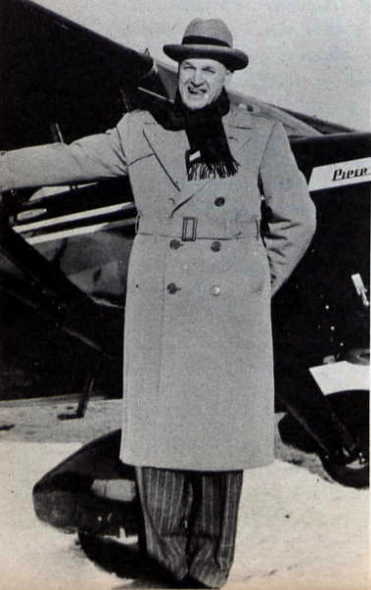
John Ramee’s passion for aviation never ceased. Here is is dressed warmly and posed with a Piper airplane (image source: USS Wasp CV/CVS/CVA-18 reunion book, pub. 1972).
Curiosity combined with the desire to accurately document Commander Ramee’s service does fuel my compulsory desire to submit a Freedom of Information Act (FOIA) request a summary of his service and awards in the near future. The discrepancy between Ramee’s awards and decorations affixed to his dress uniform and the mention of being awarded the PUC ribbon (which is absent from those on the jacket – see listing below) might indicate that there are other decorations that might be missing (such as an air medal).
- Navy Unit Commendation Ribbon
- American Defense Medal (with hole from missing device)
- American Campaign Medal
- Asiatic Pacific Campaign Medal – WWII (7 campaigns)
- World War II Victory Medal
- National Defense Service Medal (Korean Wartime service)
- Philippine Liberation Medal – World War II

Still in need of being dry cleaned and pressed, Ramee’s uniform looks far having the wings restored to their rightful place.
Besides Ramee’s own naval career, he comes from a family of servants to the nation. He was born on December 4, 1911 in the Philippines to Per Ramee, a Swedish immigrant (class of 1904, West Point) and Frances Ruth Wyman, the daughter of a Civil War veteran from Minnesota. At the time of John’s birth, John’s father, Per was a young officer serving in the U.S. Army. Per Ramee would serve and see action in both World Wars and would be joined in the armed forces by his three other children:
- Eric Per – Colonel, U.S. Army, West Point Class of 1935 (Silver Star Recipient, WWII)
- Ruth – Major, U.S. Army Air Forces, USAF (WWII, Korea)
- Paul Wyman, Colonel U.S. Army (WWII, Korea, Vietnam)
With the cold research trail, the remainder of Commander Ramee’s life will remain untold. A final mystery surrounding the retired naval aviator is the location of his final resting place. With all of his siblings and his parents accounted for, it seems somewhat odd that John would be, as of yet, the only one of Per and Frances Ramee’s children (the oldest and the last to pass away) to not be interred.
- The replacement bullion wing shows moderate wear which will match well with the oxidized sleeve braiding and stars.
- Showing the reverse of the replacement bullion wing that will be used to restore Commander Ramee’s dress blue uniform jacket.
As soon as Commander Ramee’s jacket arrived, I began searching for a suitable replacement bullion wing to restore the jacket to its proper state. Another friend and collector colleague happened to be visiting the largest militaria convention in the United States (the Ohio Valley Military Society’s Show of Shows) which prompted me to reach out to see if he could source a suitable replacement on my behalf. After approximately an hour, three photos of bullion naval aviator wings were in my messenger app. A short time later, the wing that I selected was in my hands, ready to be placed on Ramee’s jacket (I can’t help but imagine another pilfered uniform jacket with a missing wing).
- Temporarily pinned in place, the wings are a perfect match as the shape aligns with the ghost-outline of the original. Note the three pin-holes beneath the pocket indicating a missing badge leaving yet another mystery to solve.
- Still in need of being stitched, the wings are pinned above Ramee’s original ribbon rack.
- Showing the sleeve braid and bullion line officer’s star, Ramee’s uniform is in fantastic condition.
Perhaps this story isn’t a repeat after all and it merely shines a spotlight on a specific area in which I focus my collection. Commander Ramee was a naval aviator who served along with thousands of fellow naval aviators during WWII. He never earned a valor medal nor did he become an ace. Ramee fulfilled a lengthy career of service (30 years if one counts his four years at the Naval Academy) like millions of American young men and women have. What sets him apart for me is that he served two of those years aboard the namesake-cruiser that preceded my own. It is an honor to be the caretaker of his his uniform.
Gaultney Brothers Sacrifice; USS Arizona, Iwo Jima and the USS Vincennes
Retrospective-type articles that touch upon a central topic or theme are useful for both the reader and author, especially within sites such as The Veteran’s Collection as the pulling together of related content and subject matter can shed new light and expose facts that were overlooked or previously hidden. The negative aspects of self-promotion come to light when it is very obvious that authors have run out of ideas and, rather than to have aging content remain on the front or home pages of their sites, publish fluff in order to keep up the appearance of fresh content. Another reason could be to reflect upon old content while attempting to relevantly connect it to a current event.
If readers delve into the content of this site they would discover that navy-centric militaria outnumbers the articles published within this site the the better portion of those pieces focused upon a four ships bearing the same name. Within this author’s collection are a handful of artifacts from one of the four – the second ship – to carry the name Vincennes around the globe and into war. Although my collection does encompass artifacts associated with a few other ships (those vessels aboard which members of my family served), this particular warship holds special meaning and thus is at the center of my collection focus.
Commissioned in 1937, the New Orleans Class heavy cruiser (classified as such due to her main battery consisting of eight inch guns) USS Vincennes (CA-44) plied the peacetime seas for more than four years before the Japanese attack on Pearl Harbor on December 7, 1941. Despite the elapsed time since she was placed into service, many of her crew at the start of World War II were plankowners (they were part of the original crew, present at the time of commissioning) though personnel turnover was occurring and a steady rate. New crew members were replacing veterans whose enlistments were ending or were rotating to different commands. Wartime manning requirements, impacted by combat operations, increased for many vessels by as much as twenty percent.
For the aging USS Arizona (BB-39), the near 2,300-man crew was proud that their ship carried the flag of Commander Battleship Division One, Rear Admiral Isaac C. Kidd. Arizona had been serving the U.S. Navy for more than 25 years having been placed into commission in 1916; though she never fired her massive 14-inch guns at an enemy target – not even during World War I. Three-and-a-half weeks after Thanksgiving Day in 1941, the losses of WWII would begin to touch American lives throughout the country.
In late March of 1945 in the small town of Le Roy located in McLean County, Illinois which lies just north of dead-center of the state (about 140 miles southeast of Chicago), the small farming town was feeling the economic effects of the war with rationing in full swing and a large percentage of the area’s young, able-bodied men serving and fighting in far-off lands. Le Roy’s lone celebrity, Broadway star Betty Jane Watson (cousin of Jean Stapleton of 1970s television’s All in the Family fame) gained attention in the previous year playing the role “Gertie” in Oklahoma! and was now working as singer, performing (singing) with with bands in Chicago. Le Roy was a fairly quiet and peaceful town as families awaited word from their sons, fathers, brothers and uncles who were serving in the European and Pacific theaters, hopeful of good news.

Iwo Jima 1945 – the 3rd and 4th Marine Division Cemetery was beautifully laid into the volcanic soil. Though David Gaultney was laid to rest here, he (along with all of the Marines buried here) would ultimately be removed from the island and relocated (U.S. Navy photo).
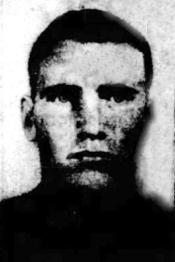
PFC David Gaultney’s Marine Corps boot camp photograph, taken in April of 1945 (image source: The Pantograph).
At the home of William Gaultney that March, things may have been quiet for the farmer-turned-road-construction worker’s family as an ominous word arrived from the War Department. From an island that until February 19, 1945 very few, if any, Americans had ever heard of, word made its way to Mr. Gaultney, via the Secretary of the Navy that his second youngest son, Private First Class David J. Gaultney was killed in combat on Iwo Jima. Nineteen year-old David was serving with “A” company of the 1st Battalion, 9th Marines (Third Marine Division) having transferred to the unit weeks before (in January) as a replacement rifleman as the unit was rearming and refitting following their heavy combat operations on Guam in late July-early August of 1944. David J. Gaultney enlisted in April of 1944 and attended recruit training in San Diego that same summer before transferring to the Sixth Replacement Draft in preparation to serve in the Pacific. David turned 19 in October as he was training to fight in the Pacific but his life would be cut short four months later. David’s father was left to grieve without his wife, Nellie who had passed away (at age 54), just 25 months earlier, afflicted by heartbreak due to the heavy toll her family had already suffered in the War.
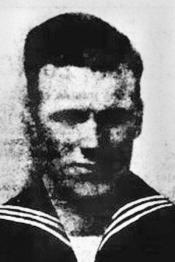
Gunner’s Mate Third Class Ralph Gaultney died from wounds sustained aboard the USS Arizona during the December 7, 1941 Pearl Harbor attack (image source: The Pantograph).
For William Gaultney, the notification of David’s loss on Iwo Jima was nothing new and one can assume that when the telegram arrived, the hesitation to open it eleven months after his son, David left for service in the Marine Corps was near-crippling for him, considering the two previous notifications that were sent to his home by the War Department, starting with word from Pearl Harbor in December of 1941. The scene portrayed on screen in the film, Saving Private Ryan as the U.S. Army car kicks up a dust cloud as it proceeds up the Ryan family farm road with Mrs. Ryan understanding what was coming; something terrible had happened to (perhaps her thoughts regarding) one of her sons. Instead, she is gripped with anguish, dropping to the porch as she reads the note handed to her by the Army officer telling her that three of her four sons had perished in combat. While the Gaultney family weren’t hit with such a magnitude as was shown in the film. However, Mrs. Gaultney suffered through two losses in less than a year with her oldest son, succumbing to his wounds (on Christmas Eve, 1941) that he sustained aboard his ship, the USS Arizona (BB-39) on December 7.
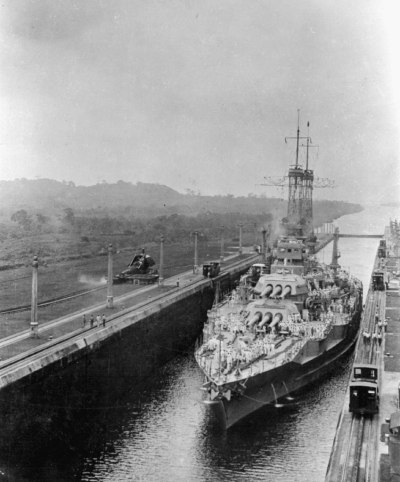
Ralph Gaultney’s ship, the USS Arizona shown transiting the Panama Canal some time before her 1930s modernization (M. S Hennessy Collection).
Ralph Martin Gaultney was the second of William and Nellie Gaultney’s children to enlist to serve in the armed forces. Ralph joined the Navy on January 16, 1940, nearly two years before the Japanese sneak attack on Pearl Harbor. Following his training, Ralph reported aboard the aging battleship on the eve of Fleet Problem XXI (the 21st in the series of large scale naval exercises conducted since 1923 and shifted to the Hawaiian waters in 1925) and would serve aboard the ship during her overhaul (in Bremerton, WA) from late 1940 to early 1941 when Admiral Isaac Kidd hoisted his flag aboard the ship (Captain Franklin Van Valkenburgh assumed command of the ship in February). The last time that Gunners Mate Third Class Ralph Gaultney would put to sea with the ship was just days before the attack. Twenty one year old Gaultney would linger for two weeks his ship was destroyed, succumbing to his wounds on December 24. Though Ralph was oldest son (there were seven children; four sons and three daughters) and the first of the Gaultney boys to perish, he wasn’t the first to join the military.

Steaming towards Guadalcanal in August 1942, the USS Vincennes (CA-44) dressed in her camouflage paint scheme, escorts the troop transports carrying the First Marine Division (M. S Hennessy Collection).
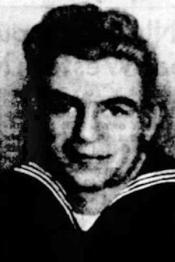
Initially listed as missing in action, Machinist Mate 1/c Leonard Gaultney perished when his ship, USS Vincennes (CA-44) was sunk on the night of August 8-9, 1942 near Savo Island in the Solomon Islands group (image source: The Pantograph).
Machinist’s Mate 1/c Leonard Gaultney had been serving in the Navy since he enlisted on September 1, 1938. Following his training, he reported aboard one of the Navy’s newest New Orleans Class heavy cruisers, the USS Vincennes (CA-44) while she was undergoing an overhaul at Mare Island Naval Shipyard in east San Francisco Bay. Having been in commission since February 24, 1937, most of the ship’s company that were present with Gaultney had been there for two years and were plankowners. When Vincennes left Mare Island, she made her way back to the Atlantic Fleet (via the Panama Canal) to serve in Neutrality Patrols as well as to retrieve some of France’s wealth (gold) for safe storage in the United States in anticipation of a German invasion. Leonard Gaultney’s ship paid a visit to Cape Town South Africa to receive yet another large shipment of gold (this time as a payment) from the United Kingdom as compensation for arms in support of their war against Germany and Italy (WWII). When the Japanese attacked Pearl Harbor, (then) Machinist Mate 2/c Gualtney’s ship was escorting a British convoy to South Africa, arriving two days later. In March of 1942, Vincennes arrived in San Francisco to join Task Force 18 and would escort USS Hornet and USS Enterprise to Japan for Colonel Doolittle’s air strike on Tokyo in April of 1942. With Japan still on the offensive, Leonard Gaultney would see action in the Battle of Midway as she screened the USS Yorktown, fighting off the Japanese air attacks. By August of 1942, USS Vincennes escorted the amphibious forces carrying the First Marine Division to the Solomon Islands. On the morning of August 7, Gaultney heard the main batteries of Vincennes commencing the shore bombardment in preparation for landing the Marines on Guadalcanal’s beachhead. During the day, Vincennes’ 5-inch and 40mm guns shot down a “Betty” bomber that was part of a Japanese air strike on the American ships landing the troops.
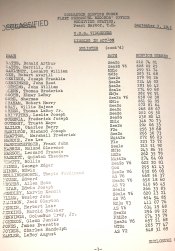
A grim reminder of naval warfare, this list of those USS Vincennes sailors who remained missing months after the ship was lost in the Battle of Savo Island, August 8-9, 1942. MM1/c Leonard Gaultney is listed among the MIA.
Sunrise in the waters between the islands of Guadalcanal, Tulagi and Savo would be MM1/c Gaultney’s last along with 331 of his USS Vincennes shipmates. That evening, the group of ships protecting the northern approach to Tulagi and Savo Islands (consisted of USS Astoria CA-34, USS Quincy CA-39 and HMAS Canberra) were caught by surprise when a Japanese cruiser task force commanded by Vice Admiral Gunichi Mikawa came upon them in the dark of night (at 01:55 am). Highly trained and proficient in night combat, the Japanese attacked and within minutes had all four ships heavily damaged, burning and sinking after opening fire with guns and Long Lance (Type 93) torpedoes. Vincennes sustained massive hits from the Japanese cruisers setting her on fire and presenting an even easier target for the IJN torpedomen to aim for. Vincennes was struck by two Type 93 torpedoes near her main spaces and she began to take on water. Fifty-five minutes later, USS Vincennes disappeared beneath the waves (at 02:50). It is not clear whether MM 1/c Gaultney made it into the water or went down with the ship though the latter is more likely considering his work space was struck by one of the torpedoes. The resulting explosion and ensuing flooding made it nearly impossible for the men who managed the propulsion systems to survive the damage let alone escape.
Some time after receiving the official notifications from the Navy (or War) Department, Mr. and Mrs. Gaultney would have been presented with their sons’ posthumous decorations (which were, most likely Purple Heart Medals). A third medal would have been presented to Mr. Gaultney in 1945 leaving him with three engraved medals – one for each son. Hopefully, all three medals have remained within the family, handed down and preserved to ensure that the memories of each of the Gaultney boys and the immense sacrifice made by this family is never forgotten. It wouldn’t be unheard of for the family to have let go of the pain of terrible loss by divesting the reminders or simply tucking them away from sight. Under such circumstances, families have been known to give Purple Heart medals (PHM) away, sell or even discard them. It wouldn’t be surprising to discover that the Gaultney medals are preserved as part of a militaria collection.
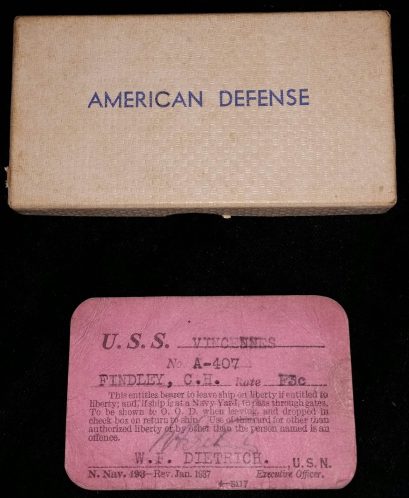
The boxed American Defense Service Medal and liberty card group from USS Vincennes (CA-44) survivor, Fireman 3/c Charles Henry Findlay.

USS Vincennes (CA-44) survivor, Charles H. Findlay, Fireman 3/c (image source: imthistory.org).
Collecting artifacts such as Purple Heart medals from service members who were killed in action is not something that interests many collectors due to the sensitive nature of the pieces and the pain and suffering (for both the one who was lost and their surviving family members) that is represented with the decorations. Though I have personal awards and decorations from sailors who served aboard the Vincennes, the pieces that I have are from two men who survived and the medals are not PHMs.
Several years ago, I was able to land a small group from a sailor, Fireman Third Class Charles Henry Findlay, who served aboard the heavy cruiser Vincennes from March of 1941 and survived its sinking. The two pieces in the group include one of his decorations, the American Defense Service Medal (ADSM) and a liberty card issued to the young sailor. One aspect of this group that collectors must keep in mind is that the ADSM is not engraved or marked with the recipient’s name (they are never personalized) which makes this particular medal difficult to prove that it was specifically awarded to Findlay.
- USS Vincennes crewman, F3/c Charles Findlay was issued this American Defense Service Medal with the “Fleet” clasp.
- Showing the back of the Findlay ADSM
- Signed by the executive officer of the USS Vincennes, W. F. Dietrich, Fireman 3/c Charles H. Findlay used this card to show that he was authorized to be on liberty and away from the ship.
- This image shows the reverse of Fireman 3/c Findlays USS Vincennes-issued liberty card.

Listed among the survivors, Fireman 3/c Findlay made it through the battle and sinking and went on to fight the enemy, serving aboard the USS Santa Fe.
What became of Fireman Findlay after being rescued from the waters that would be dubbed, “Iron Bottom Sound?” He, along with more than 50 of his USS Vincennes shipmates, were assigned to the USS Santa Fe (CL-60), a Cleveland Class light cruiser that was commissioned in November of 1942.
Though the aged and worn Navy Good Conduct Medal (NGCM) has been long separated from its suspension, drape and brooch, this medal, awarded to Seaman First Class William John Wennberg in 1939 is a great piece for my USS Vincennes (CA-44) collection. Seaman Wenneberg enlisted into the Navy on October 8, 1935 from his hometown in Chicago, Illinois, though he shown reporting aboard the Vincennes on February 24, 1937 (which corresponds with the ship’s commissioning date making him a plankowner), sixteen months after his navy career began. No muster sheets are available for Wennberg which makes his career path difficult to track until he shows up again as he reported to Receiving Ship New York on December 13, 1941, the day after he began his second enlistment. It appears that he spent a few years out of the Navy, living in New York (according to records discovered on Ancestry) and was married. Wennberg was assigned to another cruiser, USS Columbia (CL-56), the second ship of the Cleveland Class light cruisers. William Wennberg remained a seaman (equivalent to today’s E-3) from 1937 until 1945 (except for his two year break in service) when he was serving aboard the new heavy cruiser, USS Bremerton (CA-130) when he was rated as a Ship’s Serviceman Laundry 1/c.
- Missing the brooch, drape and suspension, Seaman 1/c William J. Wennbergs Navy Good Conduct Medal shows the wear and aging.
- Awarded and engraved) to Seaman 1/c William John Wennberg in 1939 while he was serving aboard the heavy cruiser, USS Vincennes.
An interesting aside, both Findlay and Wennberg served aboard Cleveland Class light cruisers following their time aboard the Vincennes. Though the coincidence isn’t that significant, the Navy chose to return the name Vincennes to the Pacific as leaders re-named the under-construction USS Flint (CL-64) to USS Vincennes, the tenth light cruiser of the 27 Cleveland Class warships. “Vincennes” and hundreds of her survivors were surviving crew were back in the fight.
For the Gaultney family, the war was over with their notification of David’s death on Iwo Jima though the grief from their terrible loss would never cease. In December of 2018, a pair of Illinois state republicans (state Senator Chapin Rose, R-Mahomet, and Representative Bill Mitchell, R-Forsyth) sponsored Senate Joint Resolution 65 which was to name the portion of I-74 that runs through Le Roy, Illinois the Gaultney Brothers Memorial Highway. The resolution passed unanimously in both the Illinois Senate and House, as reported by the Pantograph newspaper on December 31st.
Collecting, for me, focuses upon telling the story of those who can no longer do so for themselves. Preserving and displaying along with researching and documenting artifacts from service men and women helps to preserve their memories as does renaming a stretch of well-traveled highway does.
Related Articles
- Paper and Postcards – Telling a More Complete Military Story
- Calculated Risks: Bidding on Online Auctions that Contain Errors
- Subtle History – Finding a Unique Naval Militaria Piece
- A Legacy: Vincennes Wardroom Silver
“Bluestar. Put all your clients in it”

“Bluestar. Put *all* your clients in it.” – Charlie Sheen as Bud Fox in the 1987 20th Century Fox film, “Wall Street.” ((Initial theatrical release December 11, 1987. Screen capture. © 1987 Twentieth Century Fox. Credit: © 1987 Twentieth Century Fox)
One thing I am sure of, I am glad that I don’t have to compete against the likes of Gordon Gecko (or Bud Fox’s insider trading) when it comes to purchasing militaria. But something about this blue star interests me.
While the film, Wall Street was a blockbuster hit in the late 1980s it certainly isn’t the subject of this article. As I sought to reconstruct the decorations that were awarded to my uncle, a 30-year navy veteran who served from 1932 to 1962, I spent a fair amount of effort for accuracy not only in the awards but also with the period-correct specificity. One such award, when it was instituted was slightly different from what it is today.
With the signing of Executive Order 9050 on February 9, 1942, President Franklin Delano Roosevelt approved one of the most recognizable and most-senior (in order of precedence) unit awards for the United States Navy and Marine Corps, the Presidential Unit Citation (PUC). The initial criteria for this award read:
“The Secretary of the Navy is hereby authorized and directed to issue a citation in the name of the President of the United States, as public evidence of deserved honor and distinction, to any ship, aircraft, or other Naval Unit and to any Marine Corps aircraft, detachment, or higher unit, for outstanding performance in action on or after October 16, 1941.”
Just twenty days later, President Roosevelt extended a branch-specific version of the award to be available for the United States Army (Executive Order 9075).
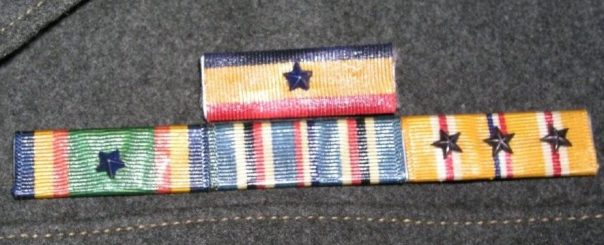
This Marine was awarded but a Navy Presidential Unit Citation and Navy Unit Commendation NUC). A star on the NUC denotes a second award however this one is oddly a PUC blue star (image source: U.S. Militaria Forum).
Both forms of the PUC were created as ribbon-only devices (meaning that there is no associated medal pendant), intended to be presented to a unit that distinguished (Merriam-Webster defines this as “marked by eminence, distinction, or excellence”) itself in combat against an enemy. Though this criteria would be further defined in 1957 by President Eisenhower’s Executive Order 10694, the awarding of these ribbons remains limited with very few units receiving the distinction since World War II.
- A single PUV with the blue enamel mostly-worn away (image source: U.S. Militaria Forum).
- Showing the flaking blue enamel on a Navy PUC (image source: U.S. Militaria Forum).
- This Pacific theater veteran (Navy or USMC) was awarded an early Navy PUC with a blue star device (image source: U.S. Militaria Forum).
- A custom, fully-embroidered ribbon rack that was made after the Korean War was worn by an aviator features a blue star on the PUC (image source: U.S. Militaria Forum).
When the Navy’s award was initially instituted in 1942, it was done so with a unique appliance added to the ribbon. With most Navy and Marine Corps decorations, a star is representative of additional awards received. A single bronze star device added to a ribbon indicates that the wearer received the award twice while a silver star affixed would show five of the same award. In the case of the Navy’s PUC, when it was initially presented to the personnel of the decorated unit, it was done so with a single blue-enameled star device. Subsequent awarding procedure then followed protocol by affixing additional blue stars, departing from the standard procedure for other ribbon decorations.
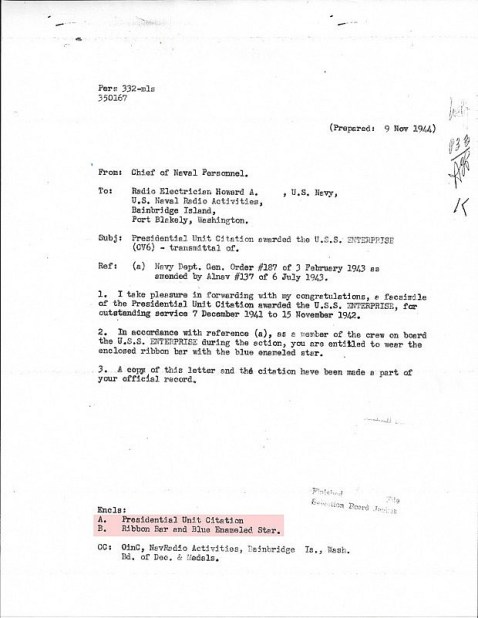
My Uncle s award letter for the Presidential Unit Citation ribbon shows the specific mention of the blue star.
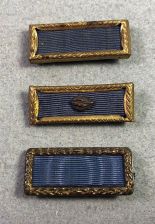
These examples of the Army Presidential Unit Citation demonstrate the differences between the two. The Army’s version features a blue ribbon with a gold metal frame. Subsequent awards are denoted with an oakleaf device (source: eBay image).
Collectors understand that it is typical for scarce, exceptional items to be highly pursued and the Navy PUC ribbon with the blue enameled star falls right in line. For the last two years, I’ve been seeking to complete a ribbon “rack” for my uncle’s display with this early variant of the Presidential Unit Citation ribbon. During that span of time, I have only seen one ribbon and star listed at auction. As I watched for my moment to bid on the ribbon, the price exceeded my threshold three days before the close, ending up more surpassing my budget fivefold.
Something tells me that Charlie Sheen’s Wall Street character, Bud Fox wasn’t referring to this wonderfully scarce ribbon device in his efforts to burn Gecko.
References:
- Sea Service Medals: Military Awards and Decorations of the Navy, Marine Corps, and Coast Guard May 1, 2009 by Fred L. Borch and Charles P. McDowell
- A Complete Guide to United States Military Medals, 1939 to Present: All Decorations, Service Medals, Ribbons and Commonly Awarded Allied Medals of the Army, Navy, Marines, Air Force and Coast Guard
Affordable, Quick and Easy Display and Storage for Your Collection

Sadly, many collectors spend more time acquiring items and less organizing and displaying their pieces, leaving them to sit in bags or boxes, tucked away (source: All Experts.com).
One of the challenges for collectors of militaria, besides trying to find space for storage, is the art of showcasing and displaying these precious artifacts.
Sadly, many collectors spend more time acquiring items and less organizing and displaying their pieces, leaving them to sit in bags or boxes, tucked away (source: All Experts.com).
Most collectors lack the expansive spaces to construct elaborate display cases that allow for propping up mannequins and life-sized dioramas. I’d imagine that the average militaria enthusiast is very similar to me in that their collection consists predominantly of small items. The lion’s share of my assemblage is made up of shoulder sleeve insignia (Army, Navy, Marine Corps and US Army Air Force), navy enlisted rank insignia (crows) and several, various naval devices, among many other pieces which include medals, ribbons and ribbon bars and a few other pins and devices.
One of the most popular display and storage tools that collectors employ are the inexpensive and easily storable two-sided boxes known as Riker cases or mounts. These simple cases are available in a wide array of sizes and dimensions providing collectors with the ability to both store and display smaller pieces, laying them flat against a cushioned polyester fill material.
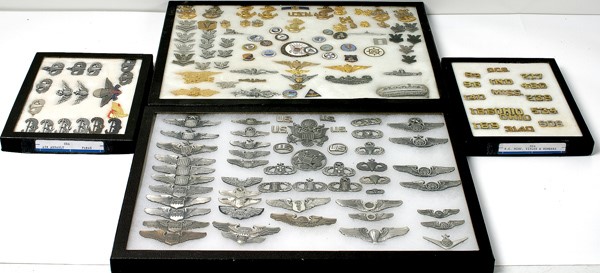
The simplistic yet functional aspects of Riker cases and mounts provide collectors with the ability to display large numbers of pieces held firmly in place (source: Cowan Auctions).
For the display of items like medals, especially vintage pieces that have become delicate due to decades of decay, placing them in a shadow box with their planchets hanging from the ribbon suspension only serves to accelerate deterioration of the threads of the ribbon. With a Riker case, the medal lays flat and is held in place, keeping the load of the medal firmly against the polyester fill material.
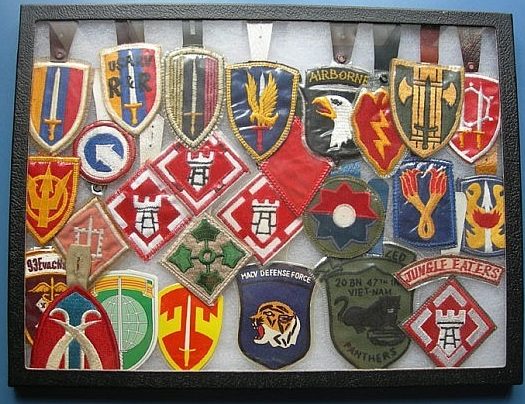
Displaying patches, such as these Vietnam War-era pocket suspended pieces, is easy (source: Beezman | Wehrmacht Awards).
One added benefit of incorporating Riker mounts into your collection storage and display plans is security and theft prevention. If you intend to show your collection in a public forum, sticky fingers are invariably going to find their way to your displays. Leaving valuable patches, medals or pins sitting on a tabletop only guarantees that you will have to replace something. Leaving your precious items displayed inside a Riker case offers your audience easy viewing yet shields you from suffering loss. Due to the case’s diminutive sizes and flat dimensions, they are easily transported between home and the show.
One downside to using Riker cases for your display is that they tend to be rather bland and ordinary, and lack the ability to hang on a wall or prop up on table. Fortunately for collectors there are crafty entrepreneurs who recognize a need for something more stylish that addresses these deficiencies. Home-Museum.com offers these beautiful yet subtle hand crafted wood frames that wrap around Rikers, providing a touch of sophistication.
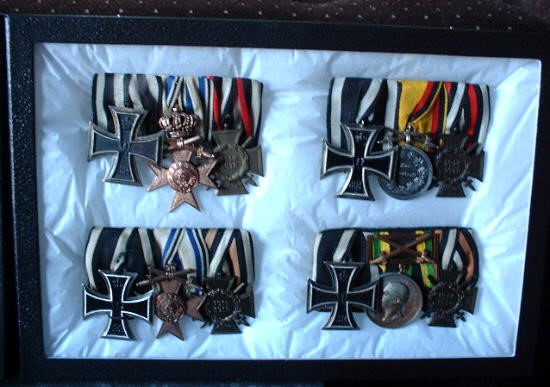
This Riker case contains a nice collection of WWI Imperial German medals and decorations. The collector added a more decorative backing material to add some character to the display (source: Mike Huxley | Pickelhaubes.com).
Bear in mind that while some Rikers incorporate glass (instead of plexiglass), it more than likely lacks UV protection for the contents. Exercise caution when hanging or displaying your Riker-mounted collection, protecting the valuable pieces from the damaging effects of light.









